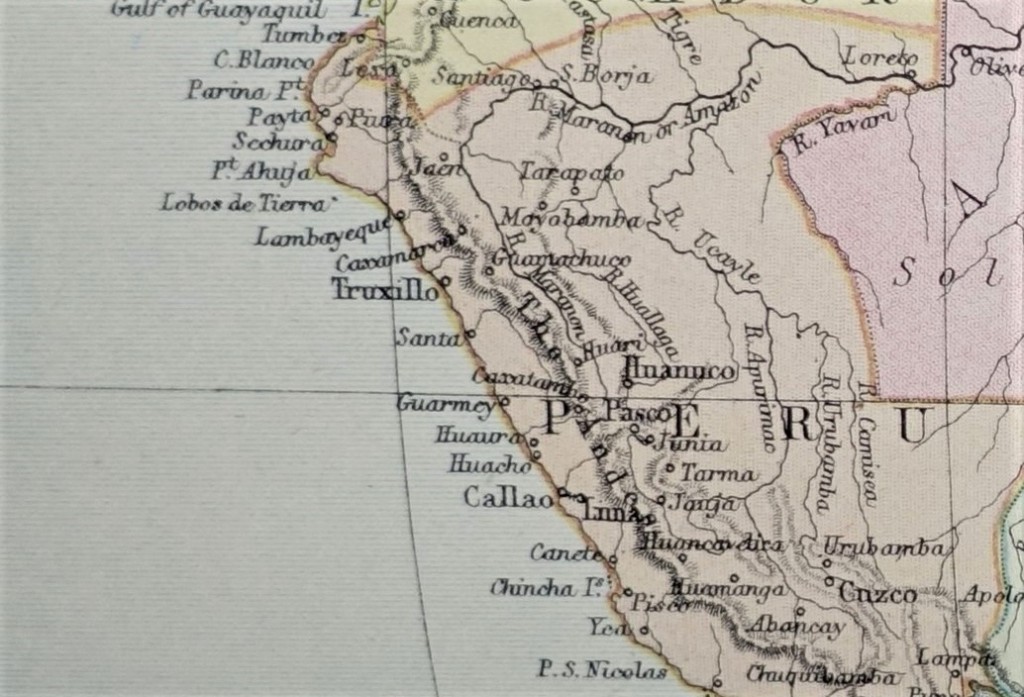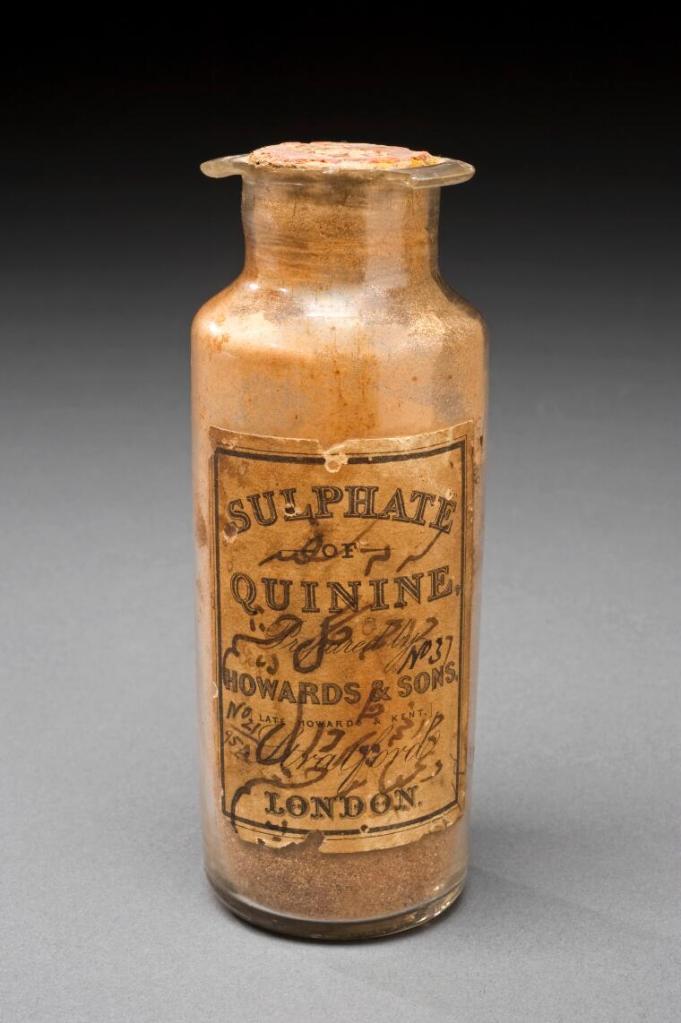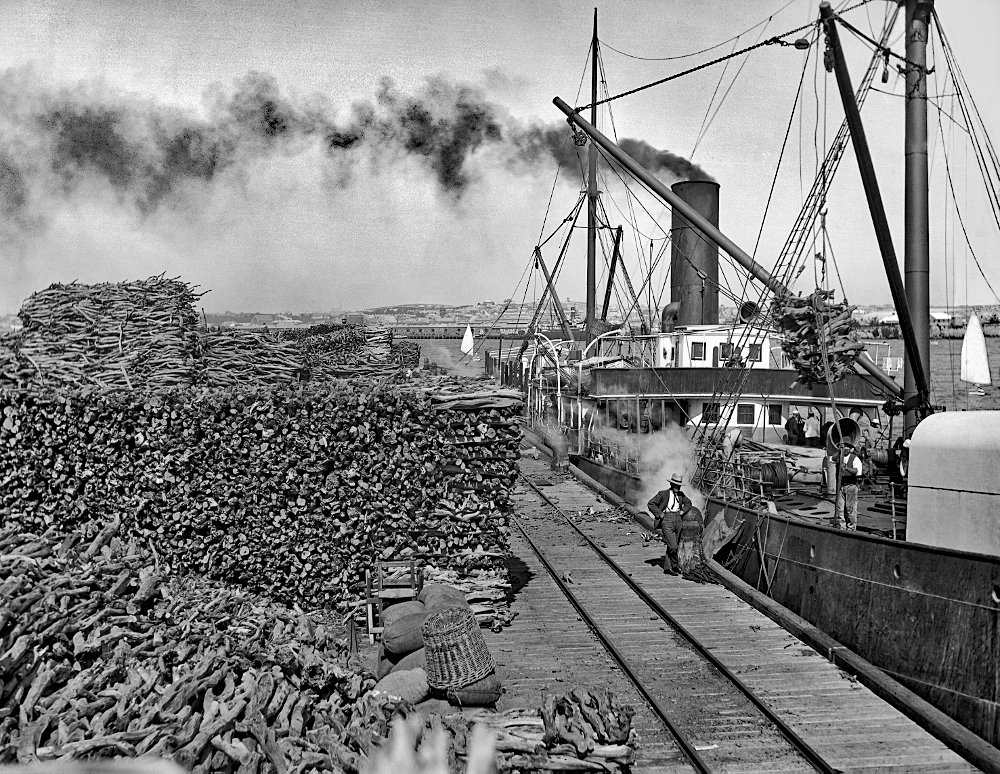
As we have seen over the previous eighteen years the mixed cargoes carried by Mercury ranged from hazardous commodities such as glass and kerosene to the staple of coal; there was also sugar and the strong smelling camphor, not forgetting the freight of live mules. We can well imagine that facing weeks at sea particularly pungent cargoes must have been trying on the senses. Carriage of sandalwood from Fremantle and then onward to Lima’s port Callao carrying tea and rice perhaps the these passages were more acceptable than some others. But all relatively good things have their limits. Both master and crew were to find their senses challenged with the next charter from Peru to Falmouth: this was the pleasure of loading and carrying Guano, bird excrement; no less than 500 tons of the organic fertiliser.
Having sailed from Hong Kong on the 26th March 1889 Mercury made port at Callao on July 5th. Well before the month was out David Thomas had fixed a charter to take guano at the Lobos Islands, to the north of Lima, an estimated 3 to 4 days of sailing. So far from home and with another passage by Cape Horn, nonetheless, the captain was anticipating being back in Britain “before the year is out”. Departing Callao on 21st July the ship arrived at Lobos on the 27th and prepared to load the highly prized Peruvian fertiliser.
Although the indigenous population had a long history of feeding their crops with guano exploitation of the excrement as a commodity on the world market was of recent origin. Unsurprisingly it was British capital which led the field, this circa 1839 (various dates are given) when Myers & Co. of Liverpool imported a small quantity of guano to gauge what the demand might be. British agriculture was then probably the most “improving” agriculture in the world. Over many decades investments had been made and new modes of crop rotation had been introduced. Crucially property relations on the land were by the 1830s dominated by cash crop production entailing the creation of a pool of wage labourers to work the land to meet the demands of an ever larger urban population. Part of this process was the drive to increase productivity by selective breeding of livestock and selection of cereals and vegetables, especially turnips; this was buttressed by careful scientific study of the impact of various fertilisers upon the land and specific crops. Chemistry became an adjunct of agriculture. As early as 1805 Humphry Davy had experimented with a small quantity of guano, identified its chemical composition and concluded “it might be supposed to be a very powerful manure”. But it took over three decades for the strong smelling guano to become an established fertiliser in British agriculture.

Its subsequent rapid adoption across Britain gives an indication of not only how efficacious, if expensive, guano was, but also tells us a great deal about the network of agricultural societies and publications which swiftly carried news of the latest developments in the industry. As early as 1841 it was being indirectly imported and sold in Aberdeen, Mercury’s home port. Merchants Nisbet & Robertson of the city’s Marischal Street had managed to obtain “a few tons” and not only offered it for sale but also said they were willing to instruct buyers on how the new-fangled manure might be used. Helpfully they published what they said was the chemical constituents of sea-bird dung. Being a valuable commodity it attracted nefarious characters selling adulterated manure, as one dealer in Peterhead to the north of Aberdeen wrote in 1843 “an immense deal of spurious trash” was on the market.
Not a source of trash but a competitor in the local market for fertiliser was the Aberdeen chemical manufacturer John Miller of Sandiland’s Chemical Works; founded in 1848, near the city’s Links and adjacent to recently opened new gas works: it was the availability of the coal-gas by-products which was the spur to establishing the chemical factory. Miller’s business argued that its chemical alternative to guano, superphosphate of lime, was the equivalent of the growth stimulant found in the organic manure. Not only this, the manufacturer warranted his inorganic fertilisers “free from adulteration”. In 1856 the company argued that the continued use of guano exhausted the soil whereas his artificial fertiliser, with a balance of ammonia and potash did not deplete the land, it was, the company claimed, “superior to guano, or any other manure used singly”. In a very interesting address he made to Aberdeen Philosophical Society John Miller argued against the import of organic manures, seeing it as a drain on the country’s financial resources. Additionally the manufacturer accused farmers of unwittingly making their lands sterile this, he said, was because the agricultural industry repeatedly applied the same foreign fertilisers without replacing the natural “salts” of the soil. His answer was to cease applications of guano and look to local alternatives, specifically artificial fertilisers used in combination with natural manures including human faeces. The businessman’s enthusiasm knew no bounds. He calculated the annual volume of human waste produced in Aberdeen, estimated its value and from a notional average diet (based on the meals supplied in the city’s Poorhouse to make the estimate deliberately conservative) came up with an approximation for the manurial value of Aberdeen’s human waste.

John Miller’s appeal of 1855 did nothing to stop the market in bird dung. There were various sources for guano, such as off the west coast of Africa none, however, could compete with the quality of the Peruvian product, the most prized being that mined from the vast deposits found in the three Chincha Islands. The fact that the climate there was very dry, with little rain, gave the sun-baked dung a naturally high chemical concentration. In 1853 the American agricultural journalist Solon Robinson wrote “The effect of guano is greater than any other highly concentrated manure ever discovered and applied to any soil. Its benefits are immediate, continuous, and unlike lime, without exhausting the soil of any of its organic matter”. In other words, Solon contradicted the claim made by John Miller and vindicated the experimental conjecture made by Humphry Davy. For brokers and shipowners the very dry nature of Peruvian guano had the added advantage of being lighter than the wetter varieties from elsewhere meaning a greater volume could be carried in ships’ holds.
Over thirty years after publication of Solon Robinson’s report guano continued to be mined for use on the agricultural land of Britain, Europe and America. So valuable had it become to the Peruvian economy that the State had after apparently selling the islands to a trading company, rescinded the sale, reclaimed ownership and henceforward controlled exploitation of the manure through a system of licensing and competitive bidding. Regular exports started in the early 1840s. Hundreds of thousands of tons were cut from the mountain of dung. Over twelve months hundreds of ships arrived and departed with the pungent commodity. In 1857, for example, 620 vessels came to the islands and carried off some 490,000 tons of guano. It was, of course, a finite resource and in a report of 1860, from the original estimate of the islands having tens of millions of tons of dung available in the 1840s it was now calculated that so severe had been extraction the supply would be exhausted by 1883. In the event this proved to be wildly optimistic: the Chincha Islands ceased to be a major source of guano by the beginning of the 1870s. Mining engineer A. J, Duffield reminisced in 1877, “When I first saw them twenty years ago, they were bold, brown heads, tall and erect, standing out of the sea . . . Now these same islands looked like creatures whose heads had been cut off, or like vast sarcophagi, like anything in short that reminds one of death and the grave”.
Hence the search was on for alternative supplies within Peruvian waters which was why the Lobos Islands north of Lima were found and exploited. Fifty years after first treating guano as a potential global marketable commodity David Thomas was taking his ship into far from easy waters. There was no comfortable quayside berth with onshore attractions. Thomas said that there “was not a drop of water or a blade of grass” to be seen. It was a matter of lying-off the islands with loading from the many lighters servicing the waiting vessels, between them conveying as much as 300 tons per day. Not only this, such were the tides that holding position to load was problematic. Mercury was he wrote was lying on the “weather side” of Lobos . . . So there is no shelter”

He continued in his letter to James Elsmie: “There is never much wind but often too much surf for lighters to work . . . We have been unfortunate since we have been here with our anchors, we have lost two, but we have got them again; first the stream anchor aft. The 15 fathom [?] worked out then one of the bow anchors. They say there is some kind of worm that eats out the wood pins. I hope we shall not lose any more as it is a bad job to get them again as we are in 14 fathoms of water”. Continuous pitching of the ship did not help with loading: gauging the weight of manure stowed, “cannot tell rightly as we are alwise rolling and kicking about I cannot judge rightly by the draft” wrote Thomas. Descriptions of the method of loading at the Chincha Islands give some idea of the kind of difficulties that crews faced. Solon Robinson wrote:
“When a vessel is ready to take in a cargo, she is moored alongside the rocks almost mast head high, from the top of which the guano is sent down through a canvas shute directly into the hold of the ship . . . several hundred tons can be put on board in a day. The trimming of the cargo is a very unpleasant part of the labor. The dust and odour is almost overpowering; so the men are obliged to come often on deck for fresh air. The rule is to remain below as long a a candle will burn . . . The guano . . . is so compact it has to be dug up with picks.”
Guano was welcomed by many in the agricultural industry who recognised how beneficial it was in raising productivity, if only it had been as kindly to the workers who mined the manure. One commentary of the 1850s caught the nightmare of the miners, “Their grim faces showed the effects of merciless treatment – long working hours, scarcity [of] food, no recreation. Scantily clothed the coolies bared their skin to the hot sun and the knotted ropes of negro task masters who kept them working at a fast pace. Their lives were short for they soon died or leapt off the cliffs crazed by torture”. Yet another report, “For the enslaved Chinamen the day dawns with labour . . . a labour which will bring no good fruit to him, and the shadows of night provide him with nothing but dreams of tormenting routine which awaits him tomorrow”. And it continues, “no hell has ever been conceived . . . equalled in the fierceness of its heat, the horror of its stink, and the damnation of those compelled to labour”.

We might well ask how labour could be attracted to such a hell? Simple, by a mixture of trickery, lies and the use of convicts. In 1863 the The Illustrated London News described most of the labour force as “free” but those who were on seven-year contracts were only free insofar as they were locked on islands of dung, with no way off and under the strictest discipline. And, as much as workers were contracted for a fixed term there was nothing in the contract committing employer to take workers to the mainland and home. As Thomas Hutchinson wrote, “this liberation rarely proves more than a delusion”. Most of the labourers were imported from China, often with stories of going to the gold diggings of California only to find themselves all but prisoners on the manure islands. In a sense they were “lucky” to have survived the passage from China to Peru. Many men died on the long passage reaching, in the case of the ship Antares, a mortality rate of 31%; 263 had embarked only 181 reached Callao. In 1872 the average death rate was 8%.
Such was the background of Captain Thomas’s journey to first Callao and then onward for hundreds of mile to the Lobos Islands where he oversaw the stowing of about 550 tons of good Peruvian guano. Then it was off on the 2nd 1889 September, round Cape Horn, making for Falmouth and home.






